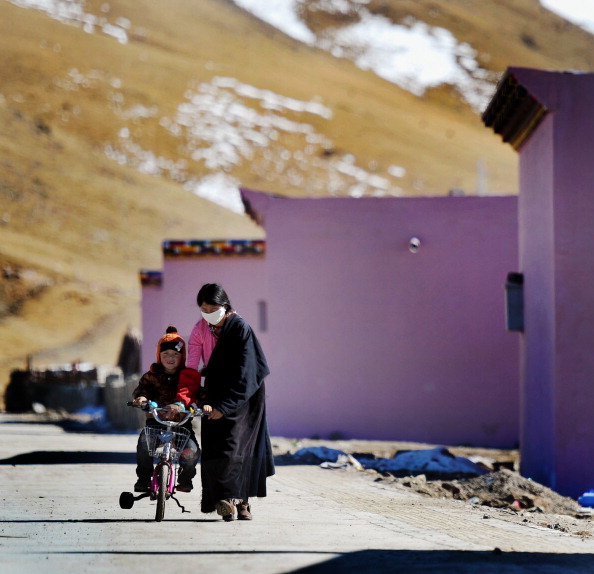
The monk leans forward and flips through the pictures. They were taken in the autumn of 2009, before the earth shook and the city fell, when we met at his monastery on an ordinary October day. Former students. Old classrooms. A friend that moved away. He lingers on a close-up of his face, as it was that day, sunlit and smiling. He shakes his head in disbelief. “Do I look so different?”
Everything does. It’s now been five years since a 7.1-magnitude earthquake hit this county — known as Yushu in Chinese and Jyekundo in Tibetan — high on the Qinghai plateau. The county seat was then a small, Tibetan city, a place of dusty markets, monasteries, and low-slung courtyard homes. The tremor toppled almost every structure and trapped thousands in the wreckage. When the valley stopped shaking, the monk and his students emerged from their still-standing school to dig, barehanded, for what remained.
Owing to distance, bad roads and altitude, it took days for rescue workers to make it to the town. But when they did, they arrived in force. Convoys of green army trucks rolled south from the provincial capital, Xining, bearing tents and blankets, cement and soldiers. Before local and foreign press, the central government promised to rebuild the city — and they did, though it is difficult, at times, to recognize the city that they built.
Beijing has poured more than $7 billion into transforming this county. Visitors no longer arrive exhausted from a 17-hour ordeal on the overnight bus. There is an airport and miles of fresh-paved roads. The main street has a brand new school with a spacious, spotless playground. And every family was given enough money to build a new, 80 sq m home.
There are also, at every turn, reminders of this. There are signs thanking the People’s Liberation Army, state-owned enterprises, and Communist Party officials. “Gratitude. Self-strengthening. Innovation. Harmony,” reads one banner. “Develop activities to promote national unity,” reads another. On the road into town, Xi Jinping, Chairman of the Communist Party and President of the People’s Republic, waves at motorists from a massive red billboard: “Unite all Chinese. Realize the China Dream.”
The ruling party’s dream for this region is, and has always been, at odds with what many ethnic Tibetans want. This is the edge of Chinese empire, a contested space where everything has two names and two histories. What Tibetans call colonization, the ruling CCP calls “serf liberation.” Even as monks burn themselves alive to protest Chinese rule, state media trumpet campaigns to improve Tibetan livelihoods through road building and water treatment.
In this sense, the story of Yushu/Jyekundo feels like the story of contemporary Tibet told in fast-forward. The earthquake’s destruction sped the influx of non-Tibetans to the once isolated town. These CCP-backed soldiers, officials and fortune seekers brought money and resources — first shovels and water, and then scaffolding and cranes. But the help was not offered without condition and has resulted in heightened state control.
Take housing. With almost all the city destroyed, the Party vowed to help every family build a new home. Generous. But they did so according to their own logic, and their own plans. Over the last five years, local residents have taken to the streets to protest what they call widespread land confiscation. After losing their homes in the quake, they said, they were evicted to make way for the new, grand city plan.
There are questions, too, about whether this construction boom benefits Tibetans. The locals had little experience in airport building, highway paving or the rapid construction of imposing government offices. The government and state-owned enterprises are experts. In the past, visitors stayed at family-owned inns. Today, there is Gesar Palace, “a boutique five star hotel” run, according to the brochure, by the Hong Kong Evergreen Hotel Group. It has “18 private Chinese dining rooms,” 13 Karaoke machines, and very few guests.
For all the talk of unity, for the shiny new buildings and smooth roads, the gap between China’s avowedly atheist government and ordinary Tibetans seems as wide as ever. You can see it in the monk’s face. The trauma of the earthquake, the influx of outsiders, and the wholesale reimagining of the town where he’s lived for 26 years have aged him, as he knows well. Though he has just entered middle age he is walking more slowly, and talking more cautiously, than he did before.
He asked that I not use his name and I will not post his pictures. This is a sensitive time for his school. The trouble started when he offered free religious education to local students on winter break. Five hundred showed up, spooking local authorities taught to see crowds of Tibetans as a threat. He spent seven days in jail, but plans to keep teaching.
He continues to live as he always has, frugally, in monk’s robes. Asked about the future, of the city and his school, he seems less concerned with matters of politics than questions of faith. The person he loves more than any other, the Dalai Lama, recently conceded that he may be the last to fill the role, a sentiment that many here are still struggling to understand. Looking down at his rebuilt city, the monk ponders somberly, “My only wish is that he’s reborn someplace free.”
—with reporting by Gu Yongqiang
More Must-Reads from TIME
- Donald Trump Is TIME's 2024 Person of the Year
- Why We Chose Trump as Person of the Year
- Is Intermittent Fasting Good or Bad for You?
- The 100 Must-Read Books of 2024
- The 20 Best Christmas TV Episodes
- Column: If Optimism Feels Ridiculous Now, Try Hope
- The Future of Climate Action Is Trade Policy
- Merle Bombardieri Is Helping People Make the Baby Decision
Write to Emily Rauhala / Yushu at emily_rauhala@timeasia.com